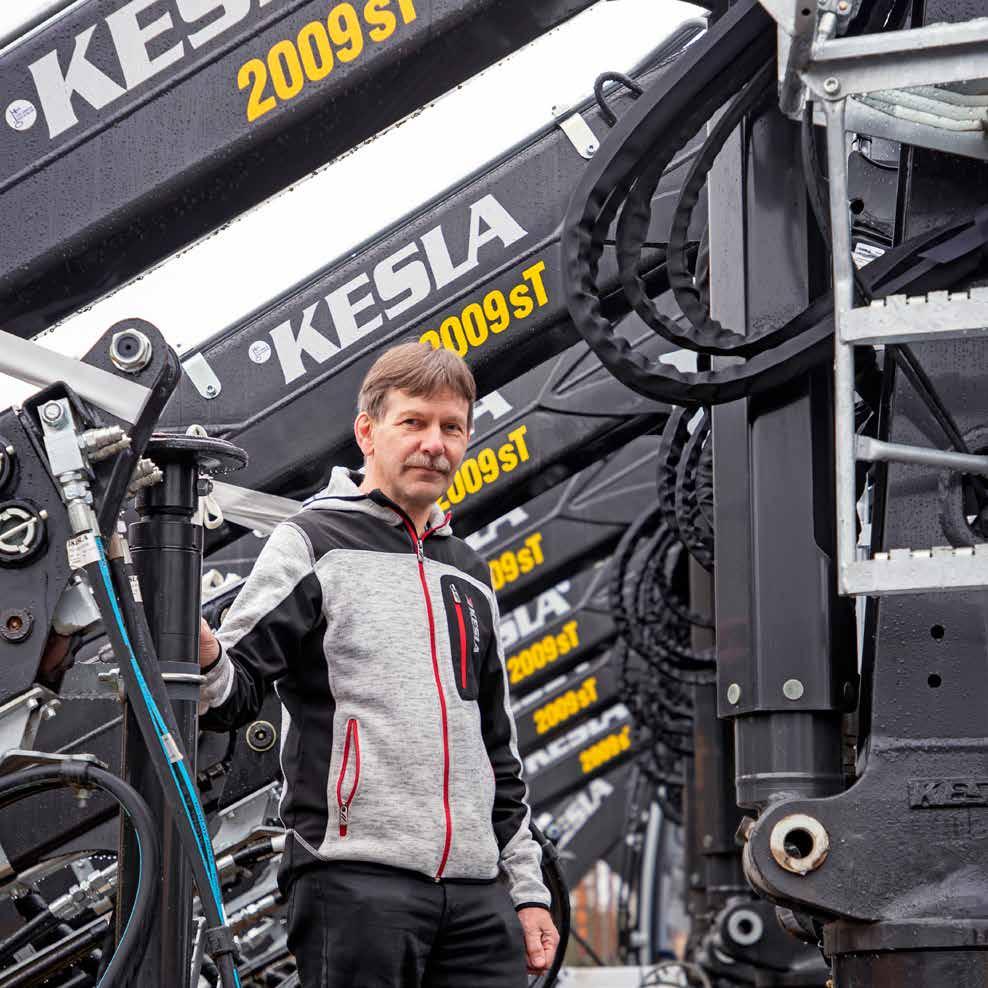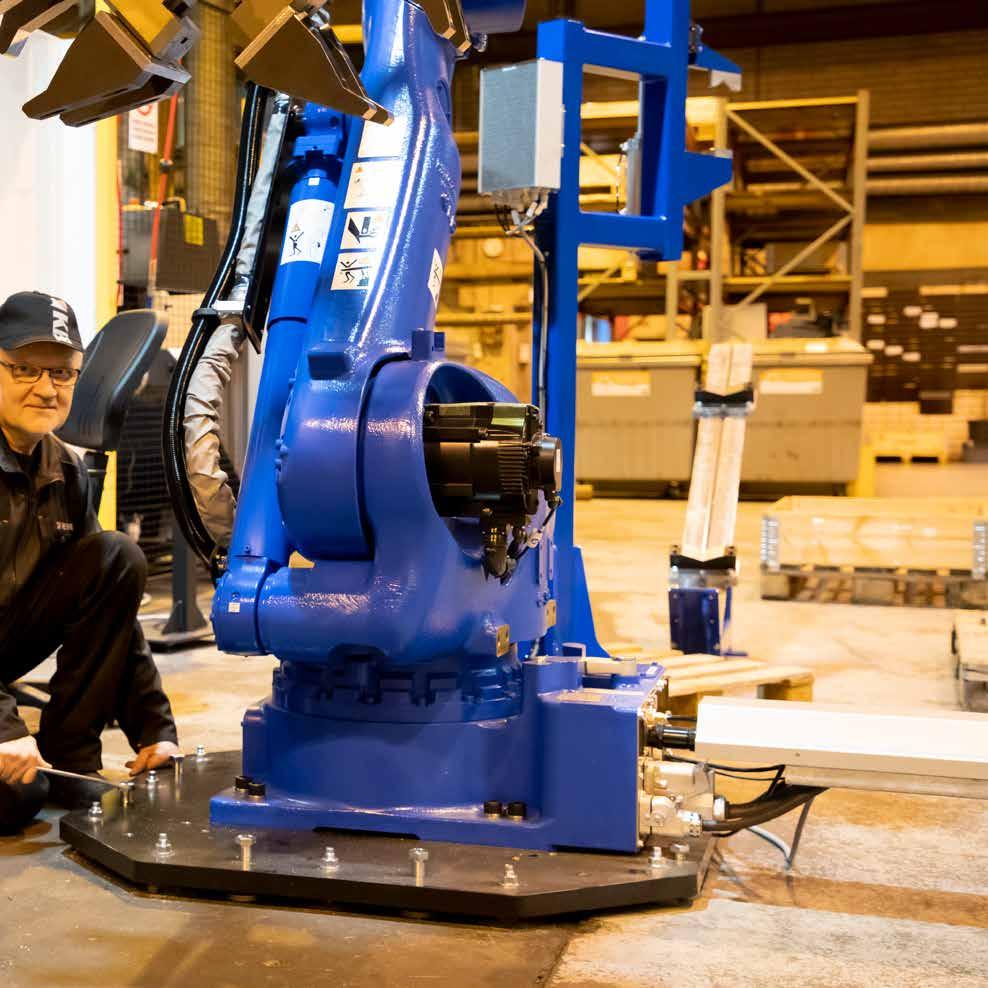
4 minute read
Success through cooperation
The FORESTERI 2009, a part of 20-series, was originally designed by Product Designer Aulis Kinnunen. The crane’s successor KESLA 2009ST is propably the most sold crane model of Kesla. It has been especially popular in Russia.
When Kesla was elected the company of the year of North Karelia in 1982, Juha Sarvi and Aulis Kinnunen were among the company’s nearly 30 employees. Sarvi’s career in Kesla began in early 1981, and Kinnunen joined in December of the same year. Erkki Lyhykäinen from Ilomantsi had joined Kartekki Ky in 1980. Juha Sarvi from Rautjärvi had graduated as a technician from Imatra Technical School in 1980. He also had vocational training in the metal industry. He came to Joensuu for a yearlong introductory training in method development. Arvo Rönkkönen, a schoolmate who joined Kesla in 1980, gave him a tip that there would be an open position for a work researcher in Kesla. “I applied and was selected. We were young and full of ideas. We looked at some of those method things and started to put the basics in order,” says Sarvi. Before joining Kesla, Aulis Kinnunen from Kitee had time to design paper machines at a design office in Rautpohja. Kinnunen’s work could be seen in Kouvola, Imatra and Svetogorsk, among others. However, the paper machine trade seemed to be shrinking and the number of colleagues around was decreasing. Kinnunen started looking for a new job. Meanwhile Kesla was looking for a Product Designer. “I came to the CEO Esko Paajanen for an interview, at the end of which he said that the position of designer has already been filled – but that they have other jobs for a good man,” Kinnunen says.
“We were young and full of ideas”
Kinnunen and Sarvi quickly developed into a dynamic work team as Kesla’s product repertoire expanded into loaders. According to the men, they had “quite a few manufacturing problems”. Prototypes had been built, but production did not succeed. “We started adjust things a little bit, even changing structures. There were no proper blueprints, either.” Eventually, the product changed to something completely new and Kinnunen’s job description changed to product development. Juha Sarvi’s strong competence was in production automation. In the utilisation of automation, Kesla was at the forefront of the industry; in 1985, Kesla alone accounted for as much as 15% of the total welding robot population in Finland.
“In the utilisation of automation Kesla was at the forefront of the industry”
“I think that the utilisation of new technology went even a little too far,” says Kinnunen, respecting the expertise of his colleague. “Well, why not? We managed to do the work as profitably as possible, we achieved a nice profit margin and did better than our competitors. We were able to simplify the product. Parts were made more complete at once and the number of welds was reduced. Aulis drew pictures that the robot could weld,” Sarvi explains. Kesla’s expansion to Joensuu took place in 1988. In the same year, Kesla also acquired a majority shareholding in Foresteri Oy, a manufacturer of timber harvesting machines in Joensuu.
“With no team around me”
In 1990, Esko Paajanen persuaded Kinnunen to move from Kesälahti to Joensuu. “Well, I went. Back then, the Karjalan Rautarakenne hall purchased from Rakennusliike Tervo was a modest building covered in soot. I was alone, with no team around me.” When the recession erupted in the early 1990s, lay-offs also started at Kesla. After being laid off, Juha Sarvi traded inaction for postgraduate studies, supplementing his knowledge in telecommunications and programming technology.
“It’s either lay-offs or we start designing new products”
Aulis Kinnunen describes how the CEO invited the employees one by one to his office. They came out of the room with a notice of dismissal or a lay-off notice. It was Kinnunen’s turn to step inside: “Esko said there are two options here. It’s either lay-offs or we start designing new products Otherwise, we won’t have things to make when the recession ends.” As the recession eased, Kesla began to change its entire IT architecture. Subsequently, Sarvi, who had trained as an ICT specialist, was also kept busy by the expansions of offices in Finland and around the world. Sarvi has continued his studies throughout his career at Kesla. In 2004 he graduated as a telecommunications engineer. He completed a master’s degree in 2013.
“I trust they’ll walk me out when the time comes”
At the time of the interview in September 2019, Sarvi and Kinnunen had a few months to go before reaching the official retirement age. Neither of them is planning to retire. “I trust they’ll walk me out when the time comes,” they say, grinning.
“Seventh guy at Kartek”
Erkki Lyhykäinen recalls that he was the seventh employee at Kartek in Ilomantsi. His career began as a young man, and even during his military service he was on the books as a Kartek employee. Lyhykäinen is responsible for the maintenance and production capacity of the Ilomantsi factory – and enjoys his work! “The work varies widely: electrical and plumbing work, repair and maintenance of machines, installation of new machinery. Each day is different, and the best thing working with people. And if there’s a problem, I can very well call a retired co-worker and ask for advice. My co-workers don’t have to be embarrassed, either, when disturbances occur and a maintenance technician is needed.” From decade to decade, the committed veteran has been the one who rushes in to help, never sparing his efforts to get production rolling. Lyhykäinen is also the man who is busy at the factory in July while others are on holiday. “It’s a tight four weeks to get it all ready again. I take my own holidays either early in the spring or in the autumn.”

The Maintenance Mechanic Erkki Lyhykäinen with Ilomantsi’s new lathe robot.










